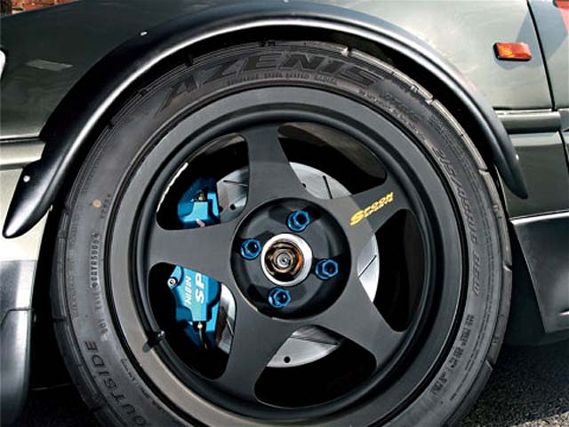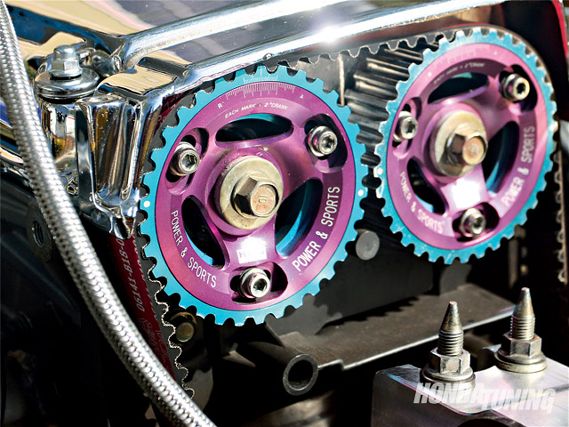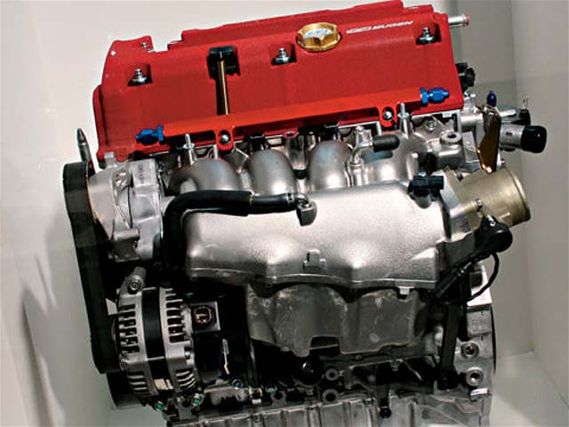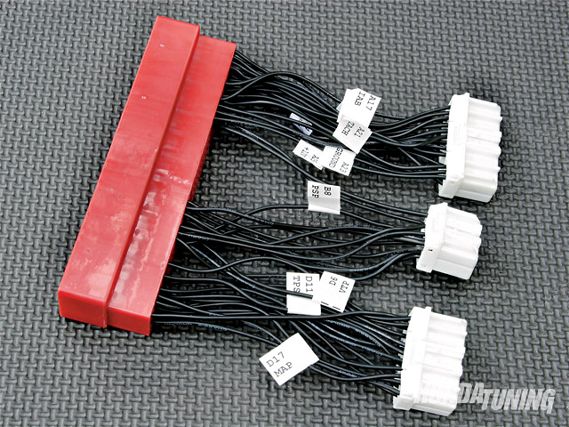Questions Answered By Honda Expert, Ryan Basseri Of Rywire * www.rywire.com
 | 1991 Honda Civic DX - Exhaust Notes
| 1991 Honda Civic DX - Exhaust Notes
Da Integra Auto-To-Manual Conversion
Dear HT, I want to start by saying that I love your magazine and it's the only one I'll read. I've been hooked ever since I first picked up a 2004 issue with an ITR in it. I just picked up an automatic '92 Integra GS for a sweet price. I want to convert it to a manual transmission but I don't know which mounts I'll need, if any. I already have a J1 transmission, clutch, flywheel, and a '91 Integra shift linkage. I know I need the pedal assembly, center console, clutch cable, intermediate shaft, and axles, all from a manual '90-'93 Integra, and a gauge cluster and five-speed ECU from a '92-'93 model. Did I miss anything? Any help would really be appreciated. Props, and keep up the good work.
Joe, Medina, Ohio
You're off to a great start, but you still need a few more things, like the transmission bracket that's welded to the Integra's frame and its corresponding rubber mount-you can get these from a manual-equipped Integra. You can buy the bracket new from Acura for less than $50 (part # 60831-SK7-J00ZZ). Drill out your automatic bracket's spot-welds, clean the surface, and weld the new one in place. As for wiring, connect the thick black wires together for the ignition lock, and wire up the green/black wire and the yellow wire for the reverse lights. You'll also need to cut a few holes here and there to get the throttle cable and shift linkage to fit correctly.
 | 1991 Honda Civic DX - Exhaust Notes
| 1991 Honda Civic DX - Exhaust Notes
Rear Disc Conversions Simplified
Hey Honda Tuning, I've been subscribing to your magazine for about two years now and read every issue from front to back. I have a '94 Civic coupe with a B18C swap and I want to do a rear disc conversion but don't know what parts will fit. I've been to several Honda forums and most of them just confuse me even more. I know I need the rear disc assembly with trailing arms, emergency brake cables, the proportioning valve, and brake master cylinder, but I don't know which parts from which car will work for me. Please help, I'm planning on some future engine mods but want to make sure I can stop first.
Paul D., somewhere in California
Luckily, the '92-'95 Civic is an extremely universal chassis, and many Honda and Acura rear disc trailing arms will bolt right on. One of the easiest places to find the goodies you're looking for is from the '90-'93 and '94-'01 Integras. You'll need the rear trailing arm assemblies, emergency brake cables, master cylinder and booster, and the proportioning valve. Don't worry about the rear upper and lower arms though; you won't need those.
More Rear Disc Conversion Tips
Hi, Exhaust Notes. I'm new to Hondas and need a little help. We have a '91 Civic DX hatchback. It's got a 1.5-liter engine with an automatic transmission. It has a power brake system with discs in front and drums out back. I'd like to improve the braking by installing discs in the rear and possibly larger ones up front. My friends tell me to go to the junkyard and just pull the hubs, rotors, and calipers from another Civic and install them on mine. Others say I'll need the entire lower control arm assembly. But nobody can tell me which years or models to get the parts from. Please help. Where should I start? Should I get the entire assembly or just bits and pieces? I should mention that I'd like to keep the 13-inch OEM wheels for cost reasons if possible. I plan on getting most of these parts from the junkyard and rebuilding them myself if necessary. Great magazine; keep up the good work.
Sam Baker, Palm Springs, California
 | 1991 Honda Civic DX - Exhaust Notes
| 1991 Honda Civic DX - Exhaust Notes
You're in luck; the Civic DX has the same size brakes as the Si. You could upgrade to the slightly larger '88-'91 EX setup, but you'd need to run 14-inch or larger wheels to do this. You'll need the entire knuckle assembly, including the calipers and rotors. And don't skimp when it comes to pads and tires-this will help more than you might think. Out back you can use any Integra, Civic, or CRX rear trailing arm assemblies, but the '90-'93 Integra's are likely the easiest to find. Find yourself a complete set of rear arms, complete with the brake assembly and emergency brake cables. The whole process is a straight swap; you can even reuse your Civic's rear upper and lower control arms.
Degree Those Cams
Dear Honda Tuning, I am currently building a naturally aspirated B18C1. I have a question concerning the engine's initial timing. I've replaced the stock connecting rods with Eagle H-beam rods of the same length and added 12.0:1 compression pistons. I also had a three-angle valve job done to the head along with porting and polishing, replaced the valvetrain with stock-sized stainless-steel valves, and added Brian Crower dual valve springs and Stage 2 camshafts. My concern is whether or not the base timing has changed, and whether or not it should be re-degreed or re-timed. Love the magazine.
Wesley Lloyd, whereabouts unknown
You should degree your engine anytime you add an aftermarket camshaft. The shop in charge of your engine build should have handled this for you but, if they didn't, you can always pick up a degree wheel and do it yourself. Simply fasten the degree wheel to the crankshaft and set the engine to Top Dead Center. Note the position of the camshafts and use the marks on the wheel to locate where exactly zero degress of camshaft timing is-keep in mind that it might be several degrees different than where your adjustable camshaft gears say it should be, depending on the camshafts you're using. As far as adjusting the ignition timing, set it to stock and leave it there until you visit the dyno.
Map Sensors Explained
Dear Honda Tuning, first, I've got to say, you're awesome. I've been a Hondaholic for eight years and still driving strong. I recently installed an LS-VTEC engine into my '91 Integra. I converted everything to OBD1 except for the MAP sensor. Is my OBD-0 MAP sensor compatible with my OBD-1 setup? My throttle body has no spot for a MAP sensor, which is why I'd like to use the old one. I've also purchased a Hondata four-bar MAP sensor but am having trouble with the S300 unit and can't change my parameters on the ECU. Is there any alternative?
Robert Casanova, whereabouts unknown
Rywire gets this question all the time. All Honda MAP sensors are 0-5V sensors and function the same way. It isn't uncommon for a MAP sensor to disappear when doing an engine swap or an OBD conversion. What was once located on top of your throttle body may not be when the new engine goes into place. Honda MAP sensors read manifold vacuum, which ultimately sends a voltage signal to the ECU, so be sure that whichever MAP sensor you use is tapped into the intake manifold. You'll also want to make sure that the three-pin electrical connector is hooked up. Unless you've got a large turbocharger strapped to your B-series running lots of boost, any of Honda's original equipment MAP sensors will work fine.
Obd-2 Ecu Tricks
I have a '98 OBD-2 Prelude and am running an aftermarket exhaust from GReddy paired with a high-flow catalytic converter. This makes the Check Engine light come on since the O2 sensor after the cat reads the same temperature as the one before the cat. The only way to make this go away is by tricking the ECU, right? How can I trick the ECU into thinking the second O2 sensor is hotter than the first?
Drew North, Melbourne, Florida
 | 1991 Honda Civic DX - Exhaust Notes
| 1991 Honda Civic DX - Exhaust Notes
There are three things you can do. First, consider converting the car to OBD-1. You'll need a jumper harness and an OBD-1 ECU to do this. The OBD-1 ECU will recognize only one oxygen sensor, and can be chipped and tuned to maximize your engine's output. This is the best method, especially if you plan on modifying the engine in the future. Your second option is to install an oxygen sensor simulator. Such simulators use a series of resistors that fool the ECU into thinking that the temperatures are hotter that what they are, but are often unpredictable and not considered a foolproof solution. Lastly, you can put your catalytic converter back on. The amount of power you've added by removing it may likely not even be worth the trouble.
Accords And K Swaps
I'm looking for information regarding engine swaps for my 10th Anniversary Edition, '93 Accord. I'd like to do either a K24 or K20 swap but can't seem to find reliable technical information anywhere. I wrote to you guys a while back and found you very helpful. If you could please let me know what parts I'll need for such a swap as well as any fabrication or modifications that I'll need to make, that would be great. I've got a year to get everything together and then I'm starting. I don't want this to look like some chop shop welded an engine into my car-I want this to be done professionally. Any information would be greatly appreciated.
Paul Gendrolis, Clearwater, Florida
There is no need for hacking when you use Hasport's kit. The swap kit is designed for the 2.4-liter K-series engines as well as the K20A Euro R engines, which all feature a different rear-mount design when compared to other K-series powerplants. Hasport designed the kit this way so that guys like you could take advantage of the higher-displacement, yet more reasonably priced K engines. You'll also need to source a Type R or Type S intermediate shaft to match up with Hasport's custom axles and a CRV right-side bracket. The rest of the swap is as you'd expect: customize some fuel lines, get creative with the radiator hoses and radiator, figure out how to get the exhaust system to line up, and call Rywire for one of its PNP conversion harnesses.
K-Series Lsds
What's up, Honda Tuning? I have an '05 EP3 Civic with a K24A4 engine swap. It's cool, but I was curious about the transmission. Of course, I'm running the stock A3's five-speed right now. Is there a way to get an LSD with this combo, or is there another tranny that I can use that has one already? I love the magazine; keep up the good work.
Anthony, somewhere in Arizona
Your best bet is to use an aftermarket LSD and upgrade to a transmission from the '05-'06 RSX. The Japanese market's Type R transmission is also an option; it's a six-speed, has a 4.7:1 final drive gear, and an OEM LSD. But the biggest issue here is that you have an '05 EP3, so the speed signal won't work with your gauge cluster. Don't worry though, there are companies out there that can convert the two signals to work together. Both the '05-'06 RSX transmission and the '02-'04 Type R have the same final drive and gear ratios, so neither is any better in that respect.
Got questions, comments, love, or hate? Send your letters to:
editorial@hondatuningmagazine.com
Or snail mail to: honda tuning, 2400 e. Katella avenue, suite 1100, anaheim, ca 92806
